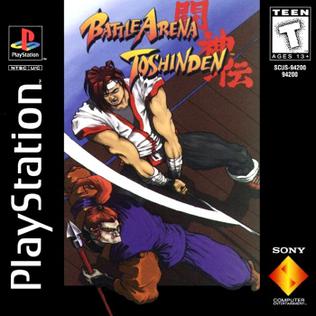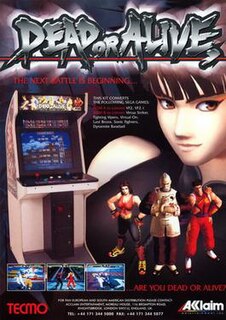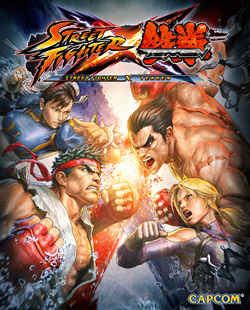| Part of a series on |
| Action games |
|---|
| |
A 3D fighting game is a subgenre of fighting games that cover games that emphasize movement on a 3D plane.
| Part of a series on |
| Action games |
|---|
| |
A 3D fighting game is a subgenre of fighting games that cover games that emphasize movement on a 3D plane.
As the name implies, 3D fighting games take place on a 3D field with either an infinite plane or walled off stages. Some stages also feature the ability to ring out an opponent similar to real life martial arts matches. Unlike 2D or platform fighting games, the majority of 3D fighting games emphasize more realistic fighting gameplay like Dead or Alive and Tekken. That said, there are some games like Dragonball Z: Budokai that feature exaggerated gameplay and not an emphasis on realism. [1] Another key aspect of 3D fighting games is the way inputs of special moves are performed. In a 2D fighting game, a player generally has to do motion commands to perform a special attack whereas in most 3D fighting games, they usually just involve a specific series of button presses to execute them. [2]
The first 3D fighting game to ever debut was the original Virtua Fighter in 1993. It was the first fighting game to feature 3D polygonal graphics. Just like how Street Fighter established the foundation that many 2D fighting games would follow, so too did Virtua Fighter establish many of the conventions that 3D fighting games would follow including the depiction of more realistic fighting gameplay and the input of button presses to simulate real life martial arts. [3]
Similar games to Virtua Fighter soon popped with Tekken releasing two years later in 1995 and eventually becoming the most popular 3D fighting game series ever. Other games would add different takes too with the Soul Calibur series featuring weapons as its main focus and Dragonball Z: Budokai having less realistic fighting styles in favor of more stylized fighting. [4]
A fighting game is a video game genre that involve combat between pairs of fighters with game elements such as blocking, grappling, counter-attacking, and chaining attacks together into "combos". Games usually display on-screen fighters from a side view, even 3D fighting games play largely within a 2D plane of motion with sidestepping. This includes close combat and long range combat.

Virtua Fighter is a fighting game created for the Sega Model 1 arcade platform by AM2, a development group within Sega, headed by Yu Suzuki. An early prototype version was location tested in Japan by August 1993, before the complete game was released worldwide in October 1993. It is the first game in the Virtua Fighter series, and the first arcade fighting game to feature fully 3D polygon graphics. The game has been ported to several platforms including the Sega Saturn, Sega 32X, and Microsoft Windows.

Soulcalibur is a weapon-based 3D fighting game developed by Project Soul and produced by Namco. It is the second game in the Soulcalibur series, preceded by Soul Edge in December 1995. Originally released in arcades on July 30, 1998, it ran on the Namco System 12 hardware. It was ported to the Dreamcast in 1999 with new features and improved graphics. The North American release was released in September 1999 as a launch game for the Dreamcast and was part of the successful launch of the new console. It became available as a downloadable title on the Xbox 360's Xbox Live Marketplace in July 2008 and it is forward compatible with the Xbox One along with the sequel, Soulcalibur II.

Tekken is a Japanese media franchise centered on a series of fighting video and arcade games developed by Bandai Namco Studios and published by Bandai Namco Entertainment. The franchise also includes film and print adaptations.

Yu Suzuki is a Japanese game designer, producer, programmer, and engineer, who headed Sega's AM2 team for 18 years. Considered one of the first auteurs of video games, he has been responsible for a number of Sega's arcade hits, including three-dimensional sprite-scaling games that used "taikan" motion simulator arcade cabinets, such as Hang-On, Space Harrier, Out Run, and After Burner, and pioneering polygonal 3D games such as Virtua Racing and Virtua Fighter, which are credited with popularizing 3D graphics in video games, as well as the critically acclaimed Shenmue series. As a hardware engineer, he led the development of various arcade system boards, including the Sega Space Harrier, Model 1, Model 2, and Model 3, and was involved in the technical development of the Dreamcast console and its corresponding NAOMI arcade hardware.

Tekken 3 (鉄拳3) is a fighting game, the third entry in the Tekken series. The original arcade game initially had a limited Japanese release in November 1996, followed by a wide international release in March 1997, before being ported for the PlayStation in 1998. The original arcade version of the game was released in 2005 for the PlayStation 2 as part of Tekken 5's Arcade History mode. The game was re-released in 2018 as part of Sony's PlayStation Classic.

Battle Arena Toshinden is a weapons-based fighting game developed by Tamsoft and published by Takara and Sony Computer Entertainment in 1995 for the PlayStation, followed by 1996 ports for the Sega Saturn, Game Boy and MS-DOS. It was one of the first fighting games to boast polygonal characters in a 3D environment, and features a sidestep maneuver which is credited for taking the genre into "true 3D." The Game Boy version of Battle Arena Toshiden despite sharing the same name as the console & PC counterparts is a different game. It is a 2D weapons based fighter and supports the Super Game Boy cartridge peripheral for the Super Nintendo Entertainment System/Super Famicom to allow the game to be played on a TV with colour palettes and borders.
Dragon Ball Z: Budokai 2, released as Dragon Ball Z2 in Japan, is a fighting video game developed by Dimps Based upon the anime and manga series, Dragon Ball Z, it is a sequel to Dragon Ball Z: Budokai for the PlayStation 2 release in 2003 and Nintendo GameCube release in 2004. It was published in Japan by Bandai and in North America by Atari.
Dragon Ball Z: Budokai 3, released as Dragon Ball Z3 in Japan, is a video game based on the popular anime series Dragon Ball Z and was developed by Dimps and published by Atari for the PlayStation 2. It was released on November 16, 2004 in North America through standard release and a Limited Edition release, which included a DVD featuring behind the scenes looks on the game's development. Europe soon saw a release on December 3, 2004. In Fall 2005, Europe obtained a new edition which included character models not available in the North American release as well as a few items and the ability to switch the voices over to Japanese. Japan later saw a release from Bandai on February 10, 2005 and also included the extras that the North American release did not have. Soon after, the Greatest Hits version in North America contained the extra features, including the ability to play with the Japanese voices.
A 2D fighting game is a subgenre of fighting games that cover games that emphasize movement on a 2d plane. 2D fighting games are notable for being the first type of any fighting game and launching the genre.

Virtua Fighter 3 is the sequel to 1994's Virtua Fighter 2 and the third fighting game in the Virtua Fighter series, developed by Sega AM2 and published by Sega in 1996. It was the first arcade game to run on the Sega Model 3 system board.

Dead or Alive is a 1996 fighting game by Tecmo and the first entry in Team Ninja's long-running Dead or Alive series. It was released first in arcades, followed by home ports for the Sega Saturn in Japan, and later for the PlayStation in all regions.
Virtua Fighter is a series of fighting games created by Sega-AM2 and designers Yu Suzuki and Seiichi Ishii. The original Virtua Fighter was released in October 1993 and has received four main sequels and several spin-offs. The highly influential first Virtua Fighter game is widely recognized as the first 3D fighting game released.

Super Dragon Ball Z is a cel-shaded 3D fighting video game, based on the Japanese manga series Dragon Ball created by Akira Toriyama. It was released in Japanese and European (2006) arcades running on System 256 hardware, and later for the PlayStation 2. The game was developed by Arika and Crafts & Meister, headed by Noritaka Funamizu. The game features 18 playable characters, destructible environments, and a game engine geared towards fans of more traditional fighting games.

Tekken (鉄拳) is a fighting video game developed and published by Namco. It was released in arcades in September 1994 and on the PlayStation in 1995. The game was well-received by critics, and it would serve as the first entry in the popular Tekken series, with a sequel, Tekken 2, being released in 1995.

Dragon Ball Z: Budokai is a series of fighting video games based on the anime series Dragon Ball Z, itself part of the larger Dragon Ball franchise.

Dragon Ball Z: Budokai Tenkaichi is a series of fighting games developed by Spike based on the Dragon Ball manga series by Akira Toriyama. The series was published by Namco Bandai Games under the Bandai brand name in Japan and Europe, and as Atari in North America and Australia from 2005 to 2007. Atari's PAL distribution network was absorbed into Bandai Namco Partners and Bandai Namco has also handled publishing in North America for future Dragon Ball Z games since 2010, effectively ending Atari's involvement.

Dragonball Evolution is a fighting video game for the PlayStation Portable based on the live-action film of the same name. The game was released in March 2009 in Japan, followed by a North American release on April 8, 2009. It is the first Dragon Ball video game to feature Bulma as a playable character.

Street Fighter X Tekken is a crossover fighting game developed by Capcom and released in March 2012 for the PlayStation 3 and Xbox 360, in May for Microsoft Windows and in October for the PlayStation Vita. The game features characters from both the Street Fighter franchise and Namco's Tekken series. In the game, each player selects two characters respectively and face other as duos in tag team fighting matches, with the objective to knock out one of the members from the opposing team. In addition to the game's multiplayer modes, the game also features a single-player Story mode with a plot revolving around a mysterious object called the "Pandora".